Related Research Articles

The basilica diSan Pietro is a Catholic basilica and abbey in the Italian city of Perugia. Its bell tower, standing at 70 meters tall, is the tallest structure in Perugia and is one of the city's most significant symbols. It is an Italian national monument

Camillo Procaccini was an Italian painter. He has been posthumously referred to as the Vasari of Lombardy, for his prolific Mannerist fresco decoration.

Cristoforo Roncalli was an Italian mannerist painter. He was one of the three painters known as Pomarancio or Il Pomarancio.
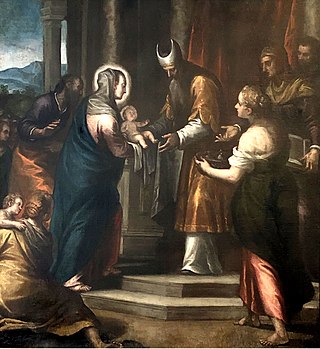
Alessandro Maganza (1556–1630) was an Italian painter of the Mannerist style, born and active in Vicenza, as well as in Venice.

Antonio d'Enrico, called Tanzio da Varallo, or simply il Tanzio was an Italian painter of the late-Mannerist or early Baroque period.
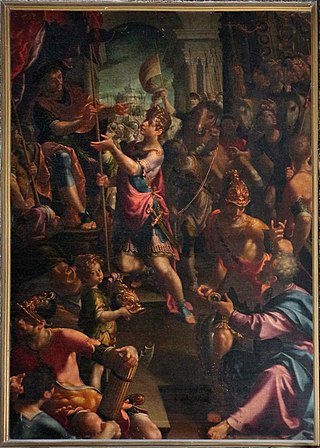
Aurelio Lomi was an Italian painter of the late-Renaissance and early-Baroque periods, active mainly in his native town of Pisa, Tuscany.
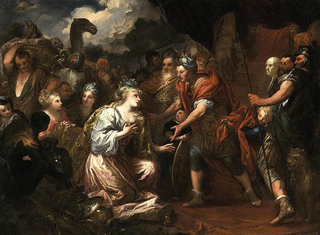
Pietro Dandini was an Italian painter of the Baroque period, active mainly in Florence.

Filippo Abbiati (1640–1715) was an Italian painter of the early-Baroque period, active in Lombardy and Turin, together with Andrea Lanzani and Stefano Maria Legnani, he was a prominent mannerist painters from the School of Lombardy. Born in Milan, he was a pupil of the painter Antonio Busca. Alessandro Magnasco was one of his pupils along with Pietro Maggi and Giuseppe Rivola. Ticozzi claims he trained, along with Federigo Bianchi, with Carlo Francesco Nuvolone. Along with Bianchi, he painted the cupola of Sant'Alessandro Martire in Milan. Abbiati also painted a St. John preaching in the Wilderness for a church in Saronno.

Giovanni Giacomo Barbelli was an Italian painter of the Baroque period, active in Lombardy. He was a canvas and fresco painter known for his religious and mythological scenes that decorate many churches and residences in Lombardy. He was a highly skilled draughtsman and a brilliant colorist. His work shows an inventive imagination and a thorough knowledge of perspective.
Teresio Maria Languasco (1651–1698) was an Italian painter and an Augustinian friar.

The church of Santa Maria delle Grazie in Brescia is located on at the west end of Via Elia Capriolo, where it intersects with the Via delle Grazie. Built in the 16th century and remodeled in the 17th century, it still retains much of its artwork by major regional artists, including one of its three canvases by Moretto. The other two are now held at the Pinacoteca Tosio Martinengo. The interior is richly decorated in Baroque fashion. Adjacent to the church is the Sanctuary of Santa Maria delle Grazie, a neo-gothic work.

Valentino Rovisi was an Italian painter in a late Baroque style.

Matteo Pannaria or Panaria or Pannerio was an Italian painter of the late-Baroque. He was born in Palermo, Sicily and active both in Rome and Jesi. He painted a Glory of San Giovanni Nepomuceno (1753) for the church of San Giovanni Battista in Jesi. He frescoed the ovals in the ceiling of the church of Santi Quaranta Martiri in Rome. Over the nave is the Glory of San Pedro de Alcantara, while the transept crossing depicts Glory of San Pascual. He also painted Beato Giovanni of Prado in one of the chapels.
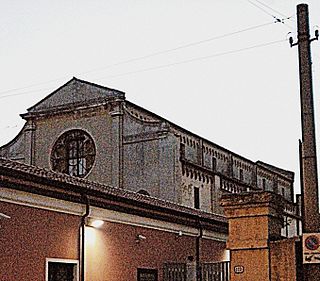
San Giovanni di Verdara or Saint John of Verdara is a former Roman Catholic monastery and church located on Via San Giovanni di Verdara # 123, in the city of Padua, region of Veneto, Italy. It was founded in 1221, but now serves as a military hospital, and is not accessible to the public.
Sant'Agostino is a Roman Catholic church, located on Via Cavour in Mondolfo, region of Marche, Italy.

Andrea da Murano, also known as Andrea di Giovanni was an Italian painter, active mainly in Venice and the Venetian mainland.
The Museum of Religious Art' is an art gallery and museum in Certaldo, opened in 2001 and one of the town's three museums.
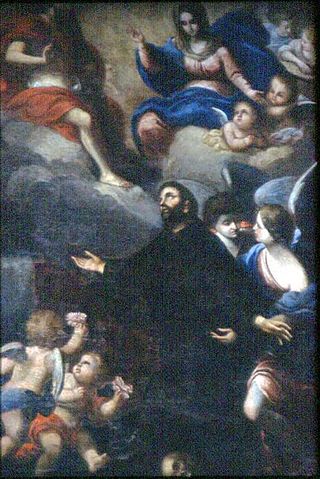
Andrea Carrera or Carreca was an Italian Baroque painter mainly active in Sicily. He was born in Trapani and died in Palermo.

Giovanni Battista Arnaud was an Italian painter of frescoes. He mastered as well, the chiaroscuro technique. His work can be found in many churches, palaces and public buildings in different regions of the north of Italy. As well in some churches of France and England. He is also recognized as a great portraitist.
Pietro Paolo Sensini was an Italian painter active in a Mannerist-style painting religious altarpieces mainly in his native city of Todi and nearby towns in Umbria.
References
- ↑ "PIETRO BACCHI (1511-1590/5)". Bassa Romagna Mia. Retrieved 2024-01-08.
- ↑ Biography of Augustinian painters.
- ↑ Biografia degli artisti ovvero dizionario della vita e delle opere dei ... By F. de Boni page 54.